Medical expert of the article
New publications
Temporal bone
Last reviewed: 06.07.2025

All iLive content is medically reviewed or fact checked to ensure as much factual accuracy as possible.
We have strict sourcing guidelines and only link to reputable media sites, academic research institutions and, whenever possible, medically peer reviewed studies. Note that the numbers in parentheses ([1], [2], etc.) are clickable links to these studies.
If you feel that any of our content is inaccurate, out-of-date, or otherwise questionable, please select it and press Ctrl + Enter.
Temporal bone(os temporale) paired, is part of the base and lateral wall of the skull between the sphenoid bone in front and the occipital bone behind. It contains the organs of hearing and balance. The temporal bone is divided into the pyramid, tympanic and squamous parts.
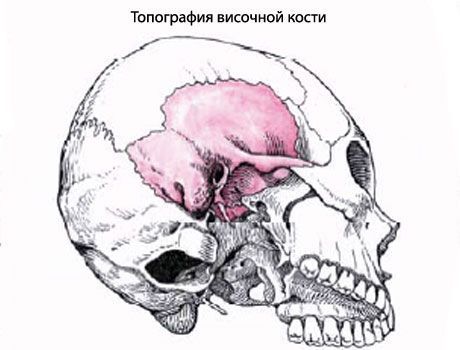
The pyramid, or petrous part (pars petrosa), has a triangular shape, located obliquely in the horizontal plane. The apex of the pyramid is directed forward and medially, and the base is directed backward and laterally. At the apex of the pyramid is the internal opening of the carotid canal (canalis caroticus). Nearby and more laterally is the muscular-tubular canal (canalis musculotubarius), which is divided by a septum into two semi-canals: the semi-canal of the auditory tube (semicanalis tubae auditivae) and the semi-canal of the muscle that tenses the eardrum (semicanalis musculi tensoris tympani).
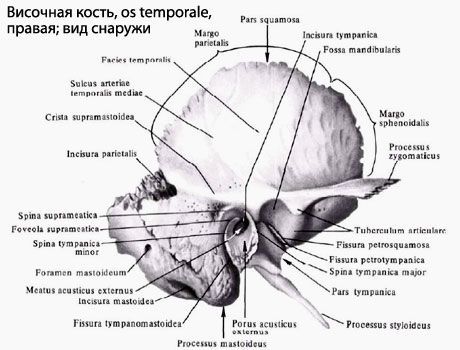
The pyramid has three surfaces: anterior, posterior, and inferior. The anterior surface of the pyramid faces upward and forward. Near the apex on this surface there is a small trigeminal impression (impressio trigemini). Lateral to this impression, two openings are visible. The larger of them is called the cleft (opening) of the canal of the greater petrosal nerve (hiatus canalis nervi petrosi majoris), from which a narrow groove of the same name runs forward and medially. Anterior and lateral is the cleft of the lesser petrosal nerve (hiatus canalis nervi petrosi minoris), which passes into the groove of this nerve. On the anterior surface of the pyramid there is a flattened area - the roof of the tympanic cavity (tegmen thympani), which is its upper wall. Along the upper edge of the pyramid is the groove of the superior petrosal sinus (sulcus sinus petrosi superioris).

The posterior surface of the pyramid faces posteriorly and medially. In the middle of this surface is the internal auditory opening (porus acusticus internus). It leads into the internal auditory canal (medtus acusticus internus). Lateral to and slightly above this opening is the subarcuate fossa (fossa subarcuata), below and lateral to which is the barely noticeable external aperture (opening) of the vestibular aqueduct (apertura externa aqueductus vestibuli). Along the posterior edge of the pyramid runs the groove of the inferior petrosal sinus (sulcus sinus petrosi inferioris). At the lateral end of this groove, next to the jugular fossa, there is a depression at the bottom of which the external aperture of the cochlear canal (apertura externa canaliculi cochleae) opens.
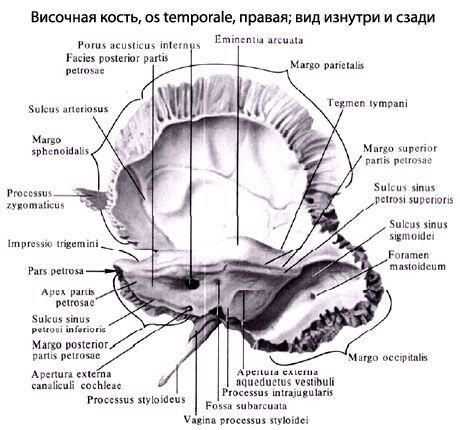
The lower surface of the pyramid has a complex relief. Near the base of the pyramid is a deep jugular fossa (fossa jugularis). In front of it is a round external opening of the carotid canal, inside of which, in its wall, there are 2-3 openings of the carotid-tympanic canals connecting the carotid canal with the tympanic cavity. On the ridge between the jugular fossa and the external opening of the carotid canal is a small lobe (fossula petrosa). Lateral to the jugular fossa, a thin and long styloid process (processus styloideus) is directed downwards. Behind the process is the stylomastoid opening (foramen stylomastoideum), and behind this opening, a wide mastoid process (processus mastoideus) is directed downwards, easily palpable through the skin.
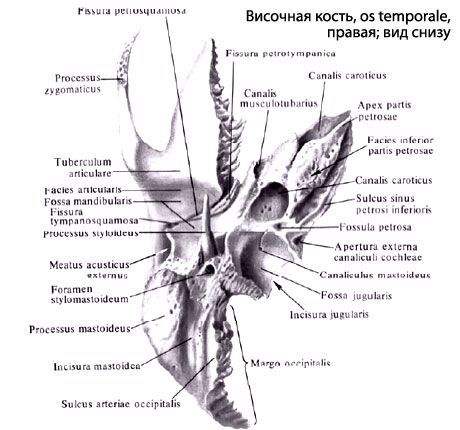
In the thickness of the mastoid process there are air-filled cells. The deepest cell - the mastoid cave (Antrum mastoideum) communicates with the tympanic cavity. Medially, the mastoid process is limited by a deep mastoid notch (incisure mastoidea). Medial to this notch is the groove of the occipital artery (sulcus arteriae occipitalis). At the base of the mastoid process there is sometimes a mastoid opening (foramen mastoideum).
The tympanic part (pars tympanica) is formed by a curved narrow bone plate, which in front, below and behind limits the external auditory opening (porus acusticus externus), leading to the external auditory canal (meatus acusticus externus). Between the tympanic part and the mastoid process is a narrow tympanomastoid fissure (fissure tympanomastoidea). In front of the external auditory opening is the tympanic-squamous fissure (fissure tympanosquamosa). A narrow bone plate, the edge of the roof of the tympanic cavity, protrudes from the inside into this fissure. As a result, the tympanic-squamous fissure is divided into the anterior petrosquamous fissure (fissura petrosquamosa) and the petrotympanic fissure (fissura petrotympanica, Glaser's fissure), through which a branch of the facial nerve, the chorda tympani, emerges from the tympanic cavity.
The squamous part (pars squamosa) is a convex plate outward, having a beveled free upper edge for connection with the parietal bone and the greater wing of the sphenoid bone. The outer temporal surface of the squamosa is smooth. On the inner medullary surface of the squamosa there are medullary eminences, finger-like depressions and arterial grooves. From the squamosa, above and in front of the external auditory canal, begins the zygomatic process (processus zygomaticus). Connecting with the temporal process of the zygomatic bone, it forms the zygomatic arch. Behind the zygomatic process, at its base, is the mandibular fossa (fossa mandibularis) for articulation with the condylar process of the lower jaw to form the temporomandibular joint.
Temporal bone canals. Several temporal bone canals for cranial nerves and blood vessels pass through the pyramid.
The carotid canal (canalis cardticus) begins on the lower surface of the pyramid with the external carotid opening, goes upward, bends almost at a right angle, then goes medially and forward. The canal ends with the internal carotid opening at the apex of the pyramid of the temporal bone. The internal carotid artery and nerves of the carotid plexus pass through this canal into the cranial cavity.

The carotid-tympanic canals (canaliculi caroticotympanic!), 2-3 in number, branch off from the carotid canal and head into the tympanic cavity. These canals contain the arteries and nerves of the same name.
The muscular-tubular canal (canalis musculotubarius) begins at the apex of the pyramid of the temporal bone, runs backwards and laterally, and opens into the tympanic cavity. A horizontal septum divides it into two parts. Above is the semicanal of the muscle that tenses the eardrum (semicanalis musculi tensoris tympani), which contains the muscle of the same name. Below is the semicanal of the auditory tube (semicanalis tubae auditivae).
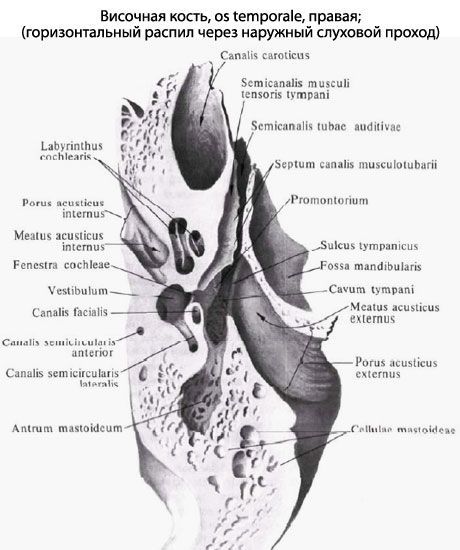
The facial canal (canalis facialis) begins in the internal auditory canal. It initially runs transversely in relation to the long axis of the pyramid to the level of the cleft of the canal of the greater petrosal nerve. Having reached the cleft, the canal forms a knee, then goes back and laterally at a right angle. Having passed along the medial wall of the tympanic cavity, the canal turns vertically downwards and ends in the stylomastoid opening. The facial nerve passes through this canal.
The canaliculus chordae tympani comes from the wall of the facial canal in its final section and opens into the tympanic cavity. A nerve, the chorda tympani, passes through this canal.
The tympanic canal (canaliculus tympanicus) begins at the bottom of the petrous fossa, goes up, pierces the wall of the tympanic cavity. Then the canal passes along its medial wall and ends in the area of the cleft of the canal of the lesser petrosal nerve. The tympanic nerve passes through this canal.
The mastoid canal (canaliculus mastoideus) begins in the jugular fossa and ends in the tympanomastoid fissure. The auricular branch of the vagus nerve passes through this canal.
Where does it hurt?
How to examine?

